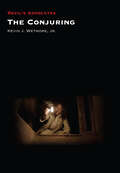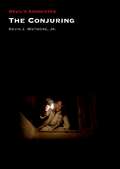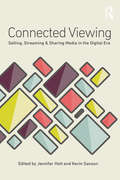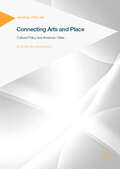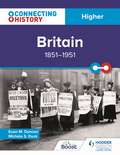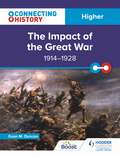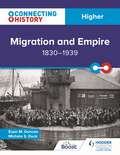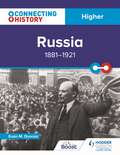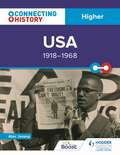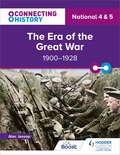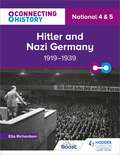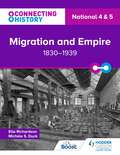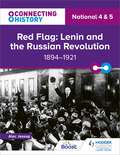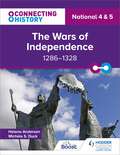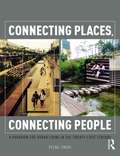- Table View
- List View
Conjugations: Marriage and Form in New Bollywood Cinema (South Asia Across the Disciplines)
by Sangita GopalBollywood movies have been long known for their colorful song-and-dance numbers and knack for combining drama, comedy, action-adventure, and music. But when India entered the global marketplace in the early 1990s, its film industry transformed radically. Production and distribution of films became regulated, advertising and marketing created a largely middle-class audience, and films began to fit into genres like science fiction and horror. In this bold study of what she names New Bollywood, Sangita Gopal contends that the key to understanding these changes is to analyze films’ evolving treatment of romantic relationships. Gopalargues that the form of the conjugal duo in movies reflects other social forces in India’s new consumerist and global society. She takes a daring look at recent Hindi films and movie trends—the decline of song-and-dance sequences, the upgraded status of the horror genre, and the rise of the multiplex and multi-plot—to demonstrate how these relationships exemplify different formulas of contemporary living. A provocative account of how cultural artifacts can embody globalization’s effects on intimate life, Conjugations will shake up the study of Hindi film.
Conjugations: Marriage and Form in New Bollywood Cinema (South Asia Across the Disciplines)
by Sangita GopalBollywood movies have been long known for their colorful song-and-dance numbers and knack for combining drama, comedy, action-adventure, and music. But when India entered the global marketplace in the early 1990s, its film industry transformed radically. Production and distribution of films became regulated, advertising and marketing created a largely middle-class audience, and films began to fit into genres like science fiction and horror. In this bold study of what she names New Bollywood, Sangita Gopal contends that the key to understanding these changes is to analyze films’ evolving treatment of romantic relationships. Gopalargues that the form of the conjugal duo in movies reflects other social forces in India’s new consumerist and global society. She takes a daring look at recent Hindi films and movie trends—the decline of song-and-dance sequences, the upgraded status of the horror genre, and the rise of the multiplex and multi-plot—to demonstrate how these relationships exemplify different formulas of contemporary living. A provocative account of how cultural artifacts can embody globalization’s effects on intimate life, Conjugations will shake up the study of Hindi film.
Conjugations: Marriage and Form in New Bollywood Cinema (South Asia Across the Disciplines)
by Sangita GopalBollywood movies have been long known for their colorful song-and-dance numbers and knack for combining drama, comedy, action-adventure, and music. But when India entered the global marketplace in the early 1990s, its film industry transformed radically. Production and distribution of films became regulated, advertising and marketing created a largely middle-class audience, and films began to fit into genres like science fiction and horror. In this bold study of what she names New Bollywood, Sangita Gopal contends that the key to understanding these changes is to analyze films’ evolving treatment of romantic relationships. Gopalargues that the form of the conjugal duo in movies reflects other social forces in India’s new consumerist and global society. She takes a daring look at recent Hindi films and movie trends—the decline of song-and-dance sequences, the upgraded status of the horror genre, and the rise of the multiplex and multi-plot—to demonstrate how these relationships exemplify different formulas of contemporary living. A provocative account of how cultural artifacts can embody globalization’s effects on intimate life, Conjugations will shake up the study of Hindi film.
The Conjuring (Devil's Advocates)
by Kevin J. Wetmore Jr.In 2013 an apparently simple, back-to-basics scary movie transformed horror cinema for the rest of the decade. Based on the allegedly true story of the Perron family haunting and subsequent investigation by ghost hunters Ed and Lorraine Warren, The Conjuring has to-date spawned six sequels and prequels, making up a Conjuring ‘universe’ that has taken over a billion dollars around the world. The New York Times called The Conjuring ‘a fantastically effective haunted-house movie’ which, following his earlier film Insidious, established director James Wan as a force in horror cinema. In this Devil’s Advocates, horror scholar Kevin Wetmore examines what elements in the film are truly terrifying, how the filmmakers’ claims of being based on a true story hold up against the actual history of the haunting and the Warrens, and the relationship between The Conjuring and the many films in its universe. Along the way this book also considers how games, toys and dolls play an important role in the series, offers a critique of gender roles in the films, and asks the question, what is actually ‘conjured’ in The Conjuring? The delightful result is an in-depth, close reading of a film that uses standard horror tropes masterfully to create a truly scary film.
The Conjuring (Devil's Advocates)
by Kevin J. Wetmore Jr.In 2013 an apparently simple, back-to-basics scary movie transformed horror cinema for the rest of the decade. Based on the allegedly true story of the Perron family haunting and subsequent investigation by ghost hunters Ed and Lorraine Warren, The Conjuring has to-date spawned six sequels and prequels, making up a Conjuring ‘universe’ that has taken over a billion dollars around the world. The New York Times called The Conjuring ‘a fantastically effective haunted-house movie’ which, following his earlier film Insidious, established director James Wan as a force in horror cinema. In this Devil’s Advocates, horror scholar Kevin Wetmore examines what elements in the film are truly terrifying, how the filmmakers’ claims of being based on a true story hold up against the actual history of the haunting and the Warrens, and the relationship between The Conjuring and the many films in its universe. Along the way this book also considers how games, toys and dolls play an important role in the series, offers a critique of gender roles in the films, and asks the question, what is actually ‘conjured’ in The Conjuring? The delightful result is an in-depth, close reading of a film that uses standard horror tropes masterfully to create a truly scary film.
Conjuring Science: A History of Scientific Entertainment and Stage Magic in Modern France
by Sofie LachapelleConjuring Science explores the history of magic shows and scientific entertainment. It follows the frictions and connections of magic and science as they occurred in the world of popular entertainment in France from the mid-eighteenth to the early twentieth century. It situates conjurers within the broader culture of science and argues that stage magic formed an important popular conduit for science and scientific enthusiasm during this period. From the scientific recreations of the fairs to the grand illusions of the theatre stage and the development of early cinema, conjurers used and were inspired by scientific and technological innovations to create illusions, provoke a sense of wonder, and often even instruct their audience. In their hands, science took on many meanings and served different purposes: it was a set of pleasant facts and recreational demonstrations upon which to draw; it was the knowledge presented in various scientific lectures accompanied by optical projections at magic shows; it was the techniques necessary to create illusions and effects on stage and later on at the cinema; and it was a way to separate conjuring from the deceit of mediums, mystical showmen and quacks in order to gain a better standing within an increasingly scientifically-minded society.
Connect the Shapes Crochet Motifs: Creative Techniques for Joining Motifs of All Shapes
by Edie EckmanConnecting beautiful motifs can be just as enjoyable as crocheting them. Edie Eckman&’s creative joining techniques allow you to easily combine multiples to form a whole new pattern, from lacy links, swirls, radiants, and wheels to three-dimensional effects. Step-by-step instructions, detailed photography, and innovative stitching charts ensure success. With 100 brand-new motif designs at your fingertips, you&’ll be free to explore limitless variations and capture your own personal style.
Connected Health in Smart Cities
This book reports on the theoretical foundations, fundamental applications and latest advances in various aspects of connected services for health information systems.The twelve chapters highlight state-of-the-art approaches, methodologies and systems for the design, development, deployment and innovative use of multisensory systems and tools for health management in smart city ecosystems. They exploit technologies like deep learning, artificial intelligence, augmented and virtual reality, cyber physical systems and sensor networks.Presenting the latest developments, identifying remaining challenges, and outlining future research directions for sensing, computing, communications and security aspects of connected health systems, the book will mainly appeal to academic and industrial researchers in the areas of health information systems, smart cities, and augmented reality.
Connected Media in the Future Internet Era
by Ahmet Kondoz Tasos DagiuklasThis book describes recent innovations in 3D media and technologies, with coverage of 3D media capturing, processing, encoding, and adaptation, networking aspects for 3D Media, and quality of user experience (QoE). The contributions are based on the results of the FP7 European Project ROMEO, which focuses on new methods for the compression and delivery of 3D multi-view video and spatial audio, as well as the optimization of networking and compression jointly across the future Internet. The delivery of 3D media to individual users remains a highly challenging problem due to the large amount of data involved, diverse network characteristics and user terminal requirements, as well as the user’s context such as their preferences and location. As the number of visual views increases, current systems will struggle to meet the demanding requirements in terms of delivery of consistent video quality to fixed and mobile users. ROMEO will present hybrid networking solutions that combine the DVB-T2 and DVB-NGH broadcast access network technologies together with a QoE aware Peer-to-Peer (P2P) distribution system that operates over wired and wireless links. Live streaming 3D media needs to be received by collaborating users at the same time or with imperceptible delay to enable them to watch together while exchanging comments as if they were all in the same location. This book is the last of a series of three annual volumes devoted to the latest results of the FP7 European Project ROMEO. The present volume provides state-of-the-art information on 3D multi-view video, spatial audio networking protocols for 3D media, P2P 3D media streaming, and 3D Media delivery across heterogeneous wireless networks among other topics. Graduate students and professionals in electrical engineering and computer science with an interest in 3D Future Internet Media will find this volume to be essential reading.
Connected Viewing: Selling, Streaming, & Sharing Media in the Digital Age
by Jennifer Holt Kevin SansonAs patterns of media use become more integrated with mobile technologies and multiple screens, a new mode of viewer engagement has emerged in the form of connected viewing, which allows for an array of new relationships between audiences and media texts in the digital space. This exciting new collection brings together twelve original essays that critically engage with the socially-networked, multi-platform, and cloud-based world of today, examining the connected viewing phenomenon across television, film, video games, and social media. The result is a wide-ranging analysis of shifting business models, policy matters, technological infrastructure, new forms of user engagement, and other key trends affecting screen media in the digital era. Connected Viewing contextualizes the dramatic transformations taking place across both media industries and national contexts, and offers students and scholars alike a diverse set of methods and perspectives for studying this critical moment in media culture.
Connected Viewing: Selling, Streaming, & Sharing Media in the Digital Age
by Jennifer Holt Kevin SansonAs patterns of media use become more integrated with mobile technologies and multiple screens, a new mode of viewer engagement has emerged in the form of connected viewing, which allows for an array of new relationships between audiences and media texts in the digital space. This exciting new collection brings together twelve original essays that critically engage with the socially-networked, multi-platform, and cloud-based world of today, examining the connected viewing phenomenon across television, film, video games, and social media. The result is a wide-ranging analysis of shifting business models, policy matters, technological infrastructure, new forms of user engagement, and other key trends affecting screen media in the digital era. Connected Viewing contextualizes the dramatic transformations taking place across both media industries and national contexts, and offers students and scholars alike a diverse set of methods and perspectives for studying this critical moment in media culture.
Connecting Arts and Place: Cultural Policy and American Cities (Sociology of the Arts)
by Eleonora RedaelliIn this book, Eleonora Redaelli investigates the arts in American cities, providing insight into urban cultural policy discourse through the lens of space. By unpacking the ways in which scholars and policymakers account for geographic configuration and spatial relation, this monograph presents a unique approach to the arts and public policy. Redaelli analyses five main concepts of the international discourse in cultural policy — cultural planning, cultural mapping, creative industries, cultural districts and creative placemaking — highlighting how each of them contributes to the understanding of how the arts connect with place. Employing a selection of American cities as case, this book is an essential contribution to our understanding of cultural policy and its effects. It will be of interest to students and scholars of sociology, public policy, urban studies, arts management and cultural studies.
Connecting History: Higher Britain, 1851–1951
by Euan M. DuncanExam board: SQALevel: HigherSubject: HistoryFirst teaching: September 2018First exam: Summer 2019Fresh stories, fresh scholarship and a fresh structure. Connecting History informs and empowers tomorrow's citizens, today.Bringing together lesser-told narratives, academic excellence, accessibility and a sharp focus on assessment success, this series provides a rich, relevant and representative History curriculum.> Connect the past to the present. Overarching themes of social justice, equality, change and power help students to understand the importance of events and issues, then and now.> Go far beyond other resources. With respect and aspiration for the transformative power of History, this series incorporates the latest research, challenges old interpretations and embeds diverse experiences throughout.> Follow a clear and consistent structure. The key issues in the specification form the chapters in each book, and the content descriptors are subheadings within the chapters. Finding the information that you need has never been easier.> Meet the demands of the assessments. Connecting History develops the knowledge and skills for success, with appropriate breadth, depth and pace. The narrative and sources take centre stage and the authors model the process of answering questions effectively through that narrative, ensuring that students have enough key points to achieve full marks. End-of-chapter activities consolidate and extend learning.> Benefit from pedagogic and academic expertise. The authors are highly experienced teachers and examiners who know how to spark critical curiosity in students. Each book has been rigorously reviewed by an academic from the University of Glasgow, so you can rest assured that the content is accurate and up to date.
Connecting History: Higher The Impact of the Great War, 1914–1928
by Euan M. DuncanExam board: SQALevel: HigherSubject: HistoryFirst teaching: September 2018First exam: Summer 2019Fresh stories, fresh scholarship and a fresh structure. Connecting History informs and empowers tomorrow's citizens, today.Bringing together lesser-told narratives, academic excellence, accessibility and a sharp focus on assessment success, this series provides a rich, relevant and representative History curriculum.> Connect the past to the present. Overarching themes of social justice, equality, change and power help students to understand the importance of events and issues, then and now.> Go far beyond other resources. With respect and aspiration for the transformative power of History, this series incorporates the latest research, challenges old interpretations and embeds diverse experiences throughout.> Follow a clear and consistent structure. The key issues in the specification form the chapters in each book, and the content descriptors are subheadings within the chapters. Finding the information that you need has never been easier.> Meet the demands of the assessments. Connecting History develops the knowledge and skills for success, with appropriate breadth, depth and pace. The narrative and sources take centre stage and the authors model the process of answering questions effectively through that narrative, ensuring that students have enough key points to achieve full marks. End-of-chapter activities consolidate and extend learning.> Benefit from pedagogic and academic expertise. The authors are highly experienced teachers and examiners who know how to spark critical curiosity in students. Each book has been rigorously reviewed by an academic from the University of Glasgow, so you can rest assured that the content is accurate and up to date.
Connecting History: Higher Migration and Empire, 1830–1939
by Euan M. Duncan Michèle Sine DuckExam board: SQALevel: HigherSubject: HistoryFirst teaching: September 2018First exam: Summer 2019Fresh stories, fresh scholarship and a fresh structure. Connecting History informs and empowers tomorrow's citizens, today.Bringing together lesser-told narratives, academic excellence, accessibility and a sharp focus on assessment success, this series provides a rich, relevant and representative History curriculum.> Connect the past to the present. Overarching themes of social justice, equality, change and power help students to understand the importance of events and issues, then and now.> Go far beyond other resources. With respect and aspiration for the transformative power of History, this series incorporates the latest research, challenges old interpretations and embeds diverse experiences throughout.> Follow a clear and consistent structure. The key issues in the specification form the chapters in each book, and the content descriptors are subheadings within the chapters. Finding the information that you need has never been easier.> Meet the demands of the assessments. Connecting History develops the knowledge and skills for success, with appropriate breadth, depth and pace. The narrative and sources take centre stage and the authors model the process of answering questions effectively through that narrative, ensuring that students have enough key points to achieve full marks. End-of-chapter activities consolidate and extend learning.> Benefit from pedagogic and academic expertise. The authors are highly experienced teachers and examiners who know how to spark critical curiosity in students. Each book has been rigorously reviewed by an academic from the University of Glasgow, so you can rest assured that the content is accurate and up to date.
Connecting History: Higher Russia, 1881–1921
by Euan M. DuncanExam board: SQALevel: HigherSubject: HistoryFirst teaching: September 2018First exam: Summer 2019Fresh stories, fresh scholarship and a fresh structure. Connecting History informs and empowers tomorrow's citizens, today.Bringing together lesser-told narratives, academic excellence, accessibility and a sharp focus on assessment success, this series provides a rich, relevant and representative History curriculum.> Connect the past to the present. Overarching themes of social justice, equality, change and power help students to understand the importance of events and issues, then and now.> Go far beyond other resources. With respect and aspiration for the transformative power of History, this series incorporates the latest research, challenges old interpretations and embeds diverse experiences throughout.> Follow a clear and consistent structure. The key issues in the specification form the chapters in each book, and the content descriptors are subheadings within the chapters. Finding the information that you need has never been easier.> Meet the demands of the assessments. Connecting History develops the knowledge and skills for success, with appropriate breadth, depth and pace. The narrative and sources take centre stage and the authors model the process of answering questions effectively through that narrative, ensuring that students have enough key points to achieve full marks. End-of-chapter activities consolidate and extend learning.> Benefit from pedagogic and academic expertise. The authors are highly experienced teachers and examiners who know how to spark critical curiosity in students. Each book has been rigorously reviewed by an academic from the University of Glasgow, so you can rest assured that the content is accurate and up to date.
Connecting History: Higher USA, 1918–1968
by Alec JessopExam board: SQALevel: HigherSubject: HistoryFirst teaching: September 2018First exam: Summer 2019Fresh stories, fresh scholarship and a fresh structure. Connecting History informs and empowers tomorrow's citizens, today.Bringing together lesser-told narratives, academic excellence, accessibility and a sharp focus on assessment success, this series provides a rich, relevant and representative History curriculum.> Connect the past to the present. Overarching themes of social justice, equality, change and power help students to understand the importance of events and issues, then and now.> Go far beyond other resources. With respect and aspiration for the transformative power of History, this series incorporates the latest research, challenges old interpretations and embeds diverse experiences throughout.> Follow a clear and consistent structure. The key issues in the specification form the chapters in each book, and the content descriptors are subheadings within the chapters. Finding the information that you need has never been easier.> Meet the demands of the assessments. Connecting History develops the knowledge and skills for success, with appropriate breadth, depth and pace. The narrative and sources take centre stage and the authors model the process of answering questions effectively through that narrative, ensuring that students have enough key points to achieve full marks. End-of-chapter activities consolidate and extend learning.> Benefit from pedagogic and academic expertise. The authors are highly experienced teachers and examiners who know how to spark critical curiosity in students. Each book has been rigorously reviewed by an academic from the University of Glasgow, so you can rest assured that the content is accurate and up to date.
Connecting History: National 4 & 5 The Era of the Great War, 1900–1928
by Alec JessopExam board: SQALevel: National 4 & 5Subject: HistoryFirst teaching: September 2017First assessment: Summer 2018Fresh stories, fresh scholarship and a fresh structure. Connecting History informs and empowers tomorrow's citizens, today.Bringing together lesser-told narratives, academic excellence, accessibility and a sharp focus on assessment success, this series provides a rich, relevant and representative History curriculum.> Connect the past to the present. Overarching themes of social justice, equality, change and power help students to understand the importance of events and issues, then and now.> Go far beyond other resources. With respect and aspiration for the transformative power of History, this series incorporates the latest research, challenges old interpretations and embeds diverse experiences throughout.> Follow a clear and consistent structure. The key issues in the N5 specification form the chapters in each book, and the content descriptors are subheadings within the chapters. Finding the information that you need has never been easier.> Meet the demands of the assessments. Connecting History develops the knowledge and skills for success, with appropriate breadth, depth and pace. The narrative and sources take centre stage and the authors model the process of answering questions effectively through that narrative, ensuring that students know all the key points that they need to. Activities throughout each chapter consolidate and extend learning.> Benefit from pedagogic and academic expertise. The authors are highly experienced teachers and examiners who know how to spark critical curiosity in students. Each book has been rigorously reviewed by an academic from the University of Glasgow, so you can rest assured that the content is accurate and up to date.
Connecting History: National 4 & 5 Hitler and Nazi Germany, 1919–1939
by Ella RichardsonExam board: SQALevel: National 4 & 5Subject: HistoryFirst teaching: September 2017First assessment: Summer 2018Fresh stories, fresh scholarship and a fresh structure. Connecting History informs and empowers tomorrow's citizens, today.Bringing together lesser-told narratives, academic excellence, accessibility and a sharp focus on assessment success, this series provides a rich, relevant and representative History curriculum.> Connect the past to the present. Overarching themes of social justice, equality, change and power help students to understand the importance of events and issues, then and now.> Go far beyond other resources. With respect and aspiration for the transformative power of History, this series incorporates the latest research, challenges old interpretations and embeds diverse experiences throughout.> Follow a clear and consistent structure. The key issues in the N5 specification form the chapters in each book, and the content descriptors are subheadings within the chapters. Finding the information that you need has never been easier.> Meet the demands of the assessments. Connecting History develops the knowledge and skills for success, with appropriate breadth, depth and pace. The narrative and sources take centre stage and the authors model the process of answering questions effectively through that narrative, ensuring that students know all the key points that they need to. Activities throughout each chapter consolidate and extend learning.> Benefit from pedagogic and academic expertise. The authors are highly experienced teachers and examiners who know how to spark critical curiosity in students. Each book has been rigorously reviewed by an academic from the University of Glasgow, so you can rest assured that the content is accurate and up to date.
Connecting History: National 4 & 5 Migration and Empire, 1830–1939
by Ella RichardsonExam board: SQALevel: National 4 & 5Subject: HistoryFirst teaching: September 2017First assessment: Summer 2018Fresh stories, fresh scholarship and a fresh structure. Connecting History informs and empowers tomorrow's citizens, today.Bringing together lesser-told narratives, academic excellence, accessibility and a sharp focus on assessment success, this series provides a rich, relevant and representative History curriculum.> Connect the past to the present. Overarching themes of social justice, equality, change and power help students to understand the importance of events and issues, then and now.> Go far beyond other resources. With respect and aspiration for the transformative power of History, this series incorporates the latest research, challenges old interpretations and embeds diverse experiences throughout.> Follow a clear and consistent structure. The key issues in the N5 specification form the chapters in each book, and the content descriptors are subheadings within the chapters. Finding the information that you need has never been easier.> Meet the demands of the assessments. Connecting History develops the knowledge and skills for success, with appropriate breadth, depth and pace. The narrative and sources take centre stage and the authors model the process of answering questions effectively through that narrative, ensuring that students know all the key points that they need to. Activities throughout each chapter consolidate and extend learning.> Benefit from pedagogic and academic expertise. The authors are highly experienced teachers and examiners who know how to spark critical curiosity in students. Each book has been rigorously reviewed by an academic from the University of Glasgow, so you can rest assured that the content is accurate and up to date.
Connecting History: National 4 & 5 Red Flag: Lenin and the Russian Revolution, 1894–1921
by Alec JessopExam board: SQALevel: National 4 & 5Subject: HistoryFirst teaching: September 2017First assessment: Summer 2018Fresh stories, fresh scholarship and a fresh structure. Connecting History informs and empowers tomorrow's citizens, today.Bringing together lesser-told narratives, academic excellence, accessibility and a sharp focus on assessment success, this series provides a rich, relevant and representative History curriculum.> Connect the past to the present. Overarching themes of social justice, equality, change and power help students to understand the importance of events and issues, then and now.> Go far beyond other resources. With respect and aspiration for the transformative power of History, this series incorporates the latest research, challenges old interpretations and embeds diverse experiences throughout.> Follow a clear and consistent structure. The key issues in the N5 specification form the chapters in each book, and the content descriptors are subheadings within the chapters. Finding the information that you need has never been easier.> Meet the demands of the assessments. Connecting History develops the knowledge and skills for success, with appropriate breadth, depth and pace. The narrative and sources take centre stage and the authors model the process of answering questions effectively through that narrative, ensuring that students know all the key points that they need to. Activities throughout each chapter consolidate and extend learning.> Benefit from pedagogic and academic expertise. The authors are highly experienced teachers and examiners who know how to spark critical curiosity in students. Each book has been rigorously reviewed by an academic from the University of Glasgow, so you can rest assured that the content is accurate and up to date.
Connecting History: National 4 & 5 The Wars of Independence, 1286–1328
by Michèle Sine Duck Helena AndersonExam board: SQALevel: National 4 & 5Subject: HistoryFirst teaching: September 2017First assessment: Summer 2018Fresh stories, fresh scholarship and a fresh structure. Connecting History informs and empowers tomorrow's citizens, today.Bringing together lesser-told narratives, academic excellence, accessibility and a sharp focus on assessment success, this series provides a rich, relevant and representative History curriculum.> Connect the past to the present. Overarching themes of social justice, equality, change and power help students to understand the importance of events and issues, then and now.> Go far beyond other resources. With respect and aspiration for the transformative power of History, this series incorporates the latest research, challenges old interpretations and embeds diverse experiences throughout.> Follow a clear and consistent structure. The key issues in the N5 specification form the chapters in each book, and the content descriptors are subheadings within the chapters. Finding the information that you need has never been easier.> Meet the demands of the assessments. Connecting History develops the knowledge and skills for success, with appropriate breadth, depth and pace. The narrative and sources take centre stage and the authors model the process of answering questions effectively through that narrative, ensuring that students know all the key points that they need to. Activities throughout each chapter consolidate and extend learning.> Benefit from pedagogic and academic expertise. The authors are highly experienced teachers and examiners who know how to spark critical curiosity in students. Each book has been rigorously reviewed by an academic from the University of Glasgow, so you can rest assured that the content is accurate and up to date.
Connecting Museums (Routledge Research in Museum Studies)
by Mark O'Neill Glenn HooperConnecting Museums explores the boundaries of museums and how external relationships are affected by internal commitments, structures and traditions. Focusing on museums’ relationship with heath, inclusion, and community, the book provides a detailed assessment of the alliances between museums and other stakeholders in recent years. With contributions from practitioners and established and early-career academics, this volume explore the ideas and practices through which museums are seeking to move beyond what might be called one-off contributions to society, to reach places where the museum is dynamic and facilitates self-generation and renewal, where it can become not just a provider of a cultural service, but an active participant in the rehabilitation of social trust and democratic participation. The contributors to this volume provide conceptual critiques and clarification of a number of key ideas which form the basis of the ethics of museum legitimacy, as well as a number of reports from the front line about the experience of trying to renew museums as more valuable and more relevant institutions. Providing internal and external perspectives, Connecting Museums presents a mix of applied and theoretical understandings of the changing roles of museums today. As such, the book should be of interest to academics, researchers and students working in the broad fields of museum and heritage studies, material culture, and arts and museum management.
Connecting Museums (Routledge Research in Museum Studies)
by Mark O'Neill Glenn HooperConnecting Museums explores the boundaries of museums and how external relationships are affected by internal commitments, structures and traditions. Focusing on museums’ relationship with heath, inclusion, and community, the book provides a detailed assessment of the alliances between museums and other stakeholders in recent years. With contributions from practitioners and established and early-career academics, this volume explore the ideas and practices through which museums are seeking to move beyond what might be called one-off contributions to society, to reach places where the museum is dynamic and facilitates self-generation and renewal, where it can become not just a provider of a cultural service, but an active participant in the rehabilitation of social trust and democratic participation. The contributors to this volume provide conceptual critiques and clarification of a number of key ideas which form the basis of the ethics of museum legitimacy, as well as a number of reports from the front line about the experience of trying to renew museums as more valuable and more relevant institutions. Providing internal and external perspectives, Connecting Museums presents a mix of applied and theoretical understandings of the changing roles of museums today. As such, the book should be of interest to academics, researchers and students working in the broad fields of museum and heritage studies, material culture, and arts and museum management.
Connecting Places, Connecting People: A Paradigm for Urban Living in the 21st Century
by Reena TiwariWhat is a better community? How can we reconfigure places and transport networks to create environmentally friendly, economically sound, and socially just communities? How can we meet the challenges of growing pollution, depleting fossil fuels, rising gasoline prices, traffic congestion, traffic fatalities, increased prevalence of obesity, and lack of social inclusion? The era of car-based planning has led to the disconnection of people and place in developed countries, and is rapidly doing so in the developing countries of the Global South. The unfolding mega-trend in technological innovation, while adding new patterns of future living and mobility in the cities, will question the relevance of face-to-face connections. What will be the ‘glue’ that holds communities together in the future? To build better communities and to build better cities, we need to reconnect people and places. Connecting Places, Connecting People offers a new paradigm for place making by reordering urban planning principles from prioritizing movement of vehicles to focusing on places and the people who live in them. Numerous case studies, including many from developing countries in the Global South, illustrate how this can be realized or fallen short of in practical terms. Importantly, citizens need to be engaged in policy development, to connect with each other and with government agencies. To measure the connectivity attributes of places and the success of strategies to meet the needs, an Audit Tool is offered for a continual quantitative and qualitative evaluation.

